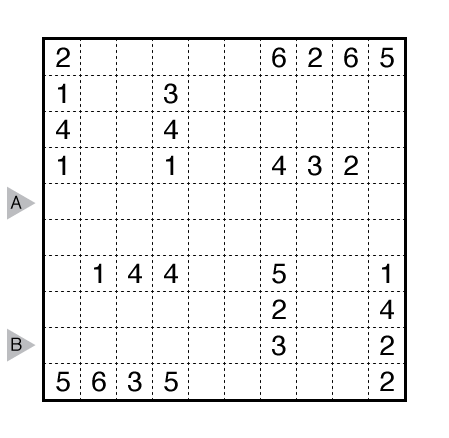From the Foxger’s Den #30: Fillomino

or solve online (using our beta test of Penpa-Edit tools; use tab to alternate between a composite mode for line/edge drawing and a number entry mode.)
Theme: 28 “dice”, opus #2 (See here for the first in Grant’s 28-given series of Fillominoes.)
Rules: Standard Fillomino rules.
Answer String: For each cell in the marked rows/columns, enter the area of the polyomino it belongs to. Start with the 5th row, followed by a comma, followed by the 9th row.
Time Standards (highlight to view): Grandmaster = 2:20, Master = 3:30, Expert = 7:00
Solution: PDF
Note: Follow this link for other classic Fillomino and this link for more variations on Fillomino puzzles. If you are new to this puzzle type, here are our easiest Fillomino puzzles to get started on.

03:24. Yuck.
A nice one. Well, that’s a nice unexpected surprise in the middle there.
Also, I must either practice solving without numbers or otherwise solve on paper. Solving on MS Paint with number severely affects my time. 🙁
I also do these in Paint (well, Paint.NET, which is more robust) and Fillomino doesn’t really lend itself well to it.
I can’t solve without numbers. Last time the subject came up, someone described the numbers as nothing more than “notes”…but how do you know that you’re done dividing a region if you don’t put a number in it to say “I am done with this cell?” That boggles my mind.
I often find myself drawing “lines” that link together cells and when there are hidden polyominoes at the end, I just have a region border drawn in with a branching line into every cell. Sometimes a single cell gets a number.
I tend to do that as well nowadays, except I put in at least 1 number per polyomino (so I know how big they are). However, it has bitten me before (and in fact today, for the large hidden region), which means I probably need more practice with this.
@Scott, you can draw lines linking cells, and when a region is finished cross the end of the line with a ‘T’ to mark it as done.
Instead of typing in numbers in Paint, I’ve sort of trained myself into an artificial synesthesia of 1=red, 2=yellow, and so on, so that I can just flood-fill each cell with the appropriate color. It gets kind of muddy with numbers past ten or so, though.
That’s also my method when I solve casually (not competitively). (When competitively, I draw lines for the polyominoes and some borders when I can’t see obvious progress.)
To everyone trying to solve filomino in MS Paint: http://www.chiark.greenend.org.uk/~sgtatham/puzzles/
If you can’t figure out how to enter a specific game, you probably shouldn’t be working these puzzles anyway.
For sufficiently large puzzles, like puzzle 500 on my other blog, it would be extremely inefficient and impractical to use that applet. But even with a 10×10 puzzle, some people can more efficiently solve in Paint than transcribe 100 numbers.
Also, that applet is limited to polyominoes of size at most 9. Any applet that limits the size of the polyominoes (except for the obvious maximum size of the whole grid) is bad. Cue in all those marvelous puzzles with polyominoes of size 10 or more.